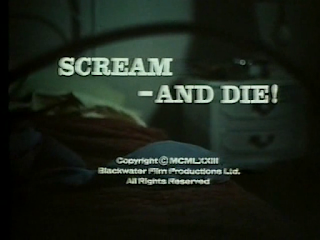This film is dark, no, really dark, so dark that
for long passages you can’t see what’s happening. Now, whether that’s the
original intention or just the result of the copy of an old VHS I watched is
another matter altogether. This was Spanish director José Ramón Larraz’s fourth
film and the first he made in Britain – he’s probably best known for Symptoms
(1974) as well as Vampyres (1974) but he had a long career mostly back
home. His style here is deliberate and slow, building up the tension and
vulnerability of the main characters and playing against an off-beat background
in which things are either not as they seem or entirely as they may well be.
So, even without the extra layers of video murk, you’re on your guard
throughout, especially as explanations are not always defined.
It features a young photographic model, Valerie Jennings
played by Andrea Allan who I thought I’d not seen before but who was a regular in Gerry
Anderson’s UFO; I didn’t recognize her without the purple wig! She is
very recognisable though and does a good job here as she’s almost ever present
throughout the film in a way that reminds you of Hitchcock’s blondes, Larraz
turns us all into voyeurs for the duration, bad things happen but we keep on
looking at the beauty. We’re all complicit in this kind of film and it is not
without some genuinely disturbing moments particularly a sequence involving the
always watchable Judy Matheson, which colours the whole film and intentionally
so.
The House That Vanished is also known as Scream...
and Die! As well as Please! Don't Go in the Bedroom (and you really,
really, don’t want to go in that bedroom…) but I think the first title is the
grandest for what is ultimately a patchy affair that whilst it is shocks intermittently
and engages throughout, ultimately it doesn’t quite hold together.
It starts off with Valerie on a modelling assignment,
going through the motions with a photographer who wants her to do some more risqué
work with him. She’s not willing to go there as she doesn’t trust his artistic
integrity although she is willing to take a chance with her very dodgy boyfriend,
Terry (Alex Leppard) who’s idea of a good time is to drive her out, off road,
into the misty woods. Terry has a little job to do and finds a grand house in
the middle of nowhere before gaining entry in search of something, although he
won’t say what.
 |
| Dark deeds as seen from the cupboard |
The resultant chase is well handled as Valerie hides away
in a scrap yard with the killer not far behind, walking deliberated knife in
hand as she shivers in terror in the back seat of a rusted car. She stays there
until morning, hitches back home where she finds Terry’s car parked outside but
there’s no sign of Terry there or at his flat.
 |
| Flats were a lot cheaper in Blomfield Road, London's Little Venice... |
So far so mysterious but then Valerie meets a strange and
attractive sculptor, Paul (Karl Lanchbury) at Mike’s shop along with his Aunt
Susanna (Maggie Walker). Paul makes intriguing ornamental masks and seems a
much more interesting chap than thuggish old Terry. Valerie starts seeing Paul
but strange things keep happening as she returns to her house to find pigeons in
the darkened basement. They’re owned by another odd gentleman a Mr. Hornby (Peter
Forbes-Robertson) who has just moved in with his flighty pets.
 |
| Seems like a relaxed kind of guy? |
So, by this point I’m counting three suspects and one no
longer as obvious as he was before the incest… the film needs to pick up the
pace though and does so with the return from holiday of Valerie’s flat mate Lorna
(Judy Matheson). Lorna provides the semblance of normality and wrong-foots the
audience long enough for the shock of her brutal murder to hit us all the
harder. It’s pretty hard to watch if I’m honest and Judy approached
it with the same degree of professionalism as all her work, it’s upsetting and unsettling.
 |
| Here's Judy |
Dusty verdict: The House That Vanished is a
weird film but it’s hardly a House of Mystery. The reveals are shocking for
their repeated juxtaposition with sexual intimacy but they’re not especially
surprising. It would almost certainly have been more visceral and horrific in
the depths of a darkened cinema… after images haunting your steps back home after
the late bus dropped you off.



















No comments:
Post a Comment